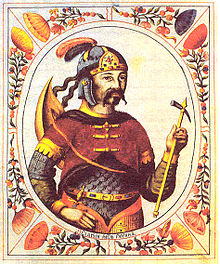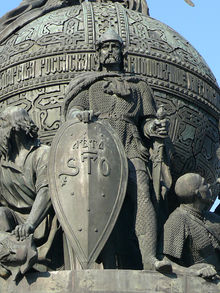Rurik: Difference between revisions
208.127.247.188 (talk) |
Nora lives (talk | contribs) →Genetic investigation: rather off-topic original research/synthesis |
||
| Line 76: | Line 76: | ||
{{see also|List of haplogroups of historical and famous figures#N (Y-DNA)}} |
{{see also|List of haplogroups of historical and famous figures#N (Y-DNA)}} |
||
According to the [[FamilyTreeDNA]] Rurikid Dynasty DNA Project, Rurik appears to have belonged to [[Haplogroup N (Y-DNA)#Haplogroup N1c1|Y-DNA haplogroup N1c1]], based on testing of his modern male line descendants.<ref>[http://www.familytreedna.com/public/rurikid/default.aspx?section=news Rurikid Dynasty DNA Project - News]</ref> But while genetically related to the later [[Baltic Finns|Baltic Finnic peoples]], the Rurikids do not possess the DYS390=24 mutation associated with the [[Finnic languages]], theirs remaining the ancestral DYS390=23, with the Rurikid haplotype itself (all values considered) more closely associated with [[North Germanic languages|Northern Germanic language]] speakers ([[Varangians]]).<ref>[http://www.mv.helsinki.fi/home/jphakkin/N1c.pdf Stratification of Y-haplogroup N1c], Jaakko Häkkinen. August 5, 2010. [[University of Helsinki]].</ref> |
According to the [[FamilyTreeDNA]] Rurikid Dynasty DNA Project, Rurik appears to have belonged to [[Haplogroup N (Y-DNA)#Haplogroup N1c1|Y-DNA haplogroup N1c1]], based on testing of his modern male line descendants.<ref>[http://www.familytreedna.com/public/rurikid/default.aspx?section=news Rurikid Dynasty DNA Project - News]</ref> But while genetically related to the later [[Baltic Finns|Baltic Finnic peoples]], the Rurikids do not possess the DYS390=24 mutation associated with the [[Finnic languages]], theirs remaining the ancestral DYS390=23, with the Rurikid haplotype itself (all values considered) more closely associated with [[North Germanic languages|Northern Germanic language]] speakers ([[Varangians]]).<ref>[http://www.mv.helsinki.fi/home/jphakkin/N1c.pdf Stratification of Y-haplogroup N1c], Jaakko Häkkinen. August 5, 2010. [[University of Helsinki]].</ref> |
||
Although it is not known what languages Rurik spoke, it is known that the Finnish - [[Meänkieli]] - language area of the modern-day Sweden in the past covered a much larger territory than it does today. [[Uppland]], where Rurik allegedly was born, was bordered by [[Norrland]], i.e. the entire northern half of today's Sweden. Norrland was not a part of Sweden during the time of Rurik's life. After [[Middle Ages]], much of the Finnish speaking population of Sweden has assimilated and mixed with the Swedish speaking population. |
|||
It also has to be noted that we cannot know for sure what haplogroup Rurik belonged to since no DNA known to originate from Rurik's body exists today. In similar cases, establishing the haplogroup of an ancient king, the scientists have had access to the actual body. The Swedish ruler [[Birger Jarl]] is an example of such DNA-investigation. Although no physical sample could be taken from the remains of Rurik's body, the FamilyTreeDNA Project could establish a firm link of many members of the Rurikid dynasty to a male born around the year [[820]] CE in the Uppland Province of Sweden. Ruriks DNA should most likely been of the haplogroup I1 (Y-DNA) or haplogroup R1b (Y-DNA). |
|||
== References == |
== References == |
||
Revision as of 06:37, 12 March 2012
| Rurik | |
|---|---|
| Prince of Novgorod | |
 Rurik in the Tsarsky Titulyarnik, 1672 | |
| Reign | 864–879 |
| Predecessor | none |
| Successor | Oleg |
| Burial | ? |
| Issue | Igor |
| Dynasty | Rurik Dynasty |
| Religion | Paganism |
Rurik or Riurik (Template:Lang-ru, Old East Norse: Rørik, meaning "famous ruler"; ca 830 – ca 879) was a Varangian chieftain who gained control of Ladoga in 862, built the Holmgard settlement near Novgorod, and founded the Rurik Dynasty which ruled Russia until the 17th century.
Name
Riurik is the Slavic rendering of the same Germanic name as the modern English Roderick, or Spanish and Portuguese Rodrigo. In old Germanic languages it had forms such as Hrodric (Old High German) and Hroðricus (Old English). In Old Norse, Hrœrekr (Norway, Iceland) and Hrørīkr or Rørik (Denmark, Sweden), from which Riurik is derived. The name also appears in Beowulf as Hrēðrīk[1].
History

There is a debate over how Rurik came to control Ladoga and Novgorod. The only information about him is contained in the 12th-century Russian Primary Chronicle, which states that Chuds, Slavs, Merias, Veses and Krivichs "…drove the Varangians back beyond the sea, refused to pay them tribute, and set out to govern themselves". Afterwards the tribes started fighting each other and decided to invite Rurik to reestablish order.
Rurik remained in power until his death in 879. His successors (the Rurik Dynasty), however, moved the capital to Kiev and founded the state of Kievan Rus, which persisted until 1240, the time of Mongol invasion. A number of extant princely families are patrilineally descended from Rurik, although the last Rurikid to rule Russia, Vasily IV, died in 1612.
There is a large 9th-century funerary barrow in Novgorod Oblast, reminiscent of the mounds at Old Uppsala. Intricately defended against looting, it remains to be excavated. The local inhabitants refer to it as Rurik's Grave.
Disputed origin
Even though some historians emphasize folklore roots for the Rurik legend and consequently dismiss Rurik as a legendary figure, there is a controversy about his ethnic origins in Eastern Europe.[citation needed]
According to the Primary Chronicle Rurik was one of the Rus, a Varangian tribe likened by the chronicler to Danes, Swedes, English and Gotlanders. In the 20th century, archaeologists partly corroborated the chronicle's version of events. It was discovered that the settlement of Ladoga, whose foundation has been ascribed to Rurik, was actually established in the mid-9th century, although doubt is now cast on this by the dendrochronological evidence that Ladoga existed by the mid-8th century. Earthenware, household utensils, and types of buildings from the period of Rurik's foundation correspond to patterns then prevalent in Jutland.

Some Slavic historians argue that the account of Rurik's invitation was borrowed by a pro-Scandinavian chronicler from a hypothetical Norse document. For instance, the Primary Chronicle states that Rurik arrived to Slavic lands with two brothers, Sineus and Truvor, and sent them to rule the towns of Beloozero and Izborsk, respectively. Instead of connecting Sineus to Signjotr and Truvor to Torvald, they suggest that the chronicler read a hypothetical Scandinavian document and misinterpreted the Norse words 'sine hus' (their houses) and 'tru voring' (with loyal guard) as the names of Rurik's brothers: Sineus and Truvor.
There is another theory that Rurik, on account of common intermarriages between Varangians and Slavic women, was of mixed Slavic-Varangian descent. This theory is based on the information of the first modern historian of Russia, Vasily Tatishchev (a Rurikid himself), who claimed that Rurik was of Wendish extraction. He went so far as to name his wife, Ufanda of Norway (Endvinda? Alfrind?); mother, Umila; his maternal grandfather, Gostomysl; and a cousin, Vadim. Those who assume good faith on Tatishchev's part point out that he based his account on the lost Ioachim Chronicle.
Hrörek of Dorestad

The only Hrörek described in Western chronicles was Rorik of Dorestad, a konung from the royal Scylding house of Haithabu. Since the 19th century, there have been attempts to identify him with the Viking prince Rurik of Russian chronicles.[1]
Roerik of Dorestad was born about 810/820 to Ali Anulo, 9th King of Haithabu. Frankish chroniclers mention that he received lands in Friesland from the Emperor Louis I. This was not enough for him, and he started to plunder neighbouring lands: he took Dorestad in 850, captured Haithabu in 857 and looted Bremen in 859. The Emperor was enraged and stripped him of all his possessions in 860. After that Roerik disappears from the Western sources for a considerable period of time. And at that very moment, in 862, the Russian Rurik arrives in the Eastern Baltic, builds the fortress of Ladoga and later moves to Novgorod.
Roerik of Dorestad reappeared in Frankish chronicles in 870, when his Friesland demesne was returned to him by Charles the Bald; in 882 he is already mentioned as dead. The Russian chronicle places the death of Rurik of Novgorod at 879. According to Western sources, the ruler of Friesland was converted to Christianity by the Franks. This may have parallels with the Christianization of the Rus', as reported by Patriarch Photius in 867.
Rurikid dynasty
The Rurikid dynasty went on to rule the Kievan Rus', and ultimately the Tsardom of Russia until 1598. Numerous noble Russian and Ruthenian families claim a male-line descent from Rurik, and via Anne of Kiev, wife of Henry I of France, Rurikid ancestry can also be argued for numerous Western European lineages.
Genetic investigation
According to the FamilyTreeDNA Rurikid Dynasty DNA Project, Rurik appears to have belonged to Y-DNA haplogroup N1c1, based on testing of his modern male line descendants.[2] But while genetically related to the later Baltic Finnic peoples, the Rurikids do not possess the DYS390=24 mutation associated with the Finnic languages, theirs remaining the ancestral DYS390=23, with the Rurikid haplotype itself (all values considered) more closely associated with Northern Germanic language speakers (Varangians).[3]
References
- ^ Rurik's identification with Hrörek was propagated by Boris Rybakov and Anatoly Kirpichnikov (see А.Н. Кирпичников: Сказание о призвании варягов. Анализ и возможности источника // Первые скандинавские чтения. - СПб., 1997. - С. 7-18). Alexander Nazarenko objects to this identification (see Nazarenko A., Rjurik и Riis Th., Rorik // Lexikon des Mittelalters. VII. - Munchen, 1995. - P. 880, 1026.)
- ^ Rurikid Dynasty DNA Project - News
- ^ Stratification of Y-haplogroup N1c, Jaakko Häkkinen. August 5, 2010. University of Helsinki.
